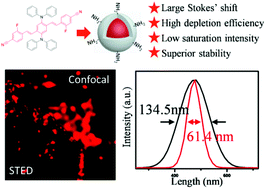Organic nanoparticles with ultrahigh stimulated emission depletion efficiency for low-power STED nanoscopy†
Abstract
Stimulated emission depletion (STED) nanoscopy is a powerful sub-diffraction imaging tool to probe subcellular structures and organelles. Conventional organic dyes require high STED power (PSTED) to obtain sub-diffraction resolution, leading to serious photo-bleaching. Herein, this study demonstrates highly emissive silica-coated core–shell organic nanoparticles (CSONPs) as a new type of photostable probe with ultrahigh stimulated emission depletion efficiency for low-power super-resolution STED nanoscopy. The CSONPs offer (i) efficient red emission with high solid-state fluorescence quantum yields around 0.6, (ii) large Stokes shift of 150 nm and (iii) high photostability owing to silica shell protection. The stimulated emission depletion efficiency (η) of CSONPs was extremely high up to η = 99% (the highest value reported so far) with a saturation intensity as low as Isat = 0.18 MW cm−2. Moreover, this research demonstrates the super-resolution imaging of living HeLa cells stained using CSONPs with a lateral spatial resolution of 63 nm at an extremely low depletion power of ISTED = 0.89 MW cm−2 and a long-term stability >600 s at η = 80% without obvious fatigue. The excellent and comprehensive performances of the CSONPs are promising for super-resolution imaging in biological applications.



 Please wait while we load your content...
Please wait while we load your content...